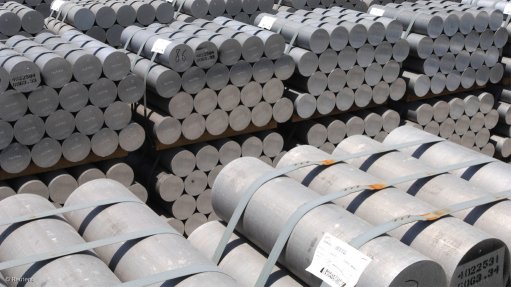
Photo by: Reuters
TORONTO (miningweekly.com) – US aluminium and speciality alloys manufacturer Alcoa has reported a 70% slide in adjusted earnings, saying strong productivity gains and solid midstream and downstream profitability were offset by low metal prices.
Excluding special items, net income for the three months ended September 30 came in at $109-million, or $0.07 a share, compared with net income of $370-million, or $0.31 a share, in the third quarter of 2014, the company advised on Thursday.
Analysts had, on average, expected adjusted earnings of $0.13 a share on sales of $5.68-billion.
After releasing its third-quarter results, Alcoa's NYSE-listed shares fell 5% to $10.46 apiece, having shed 31% since the start of the year.
New York-headquartered Alcoa reported net income of $44-million, or $0.02 a share, including $65-million in net negative special items. Special items included restructuring-related costs to improve the upstream portfolio and transaction costs, partially offset by gains on asset sales. This compared with net income of $149-million, or $0.12 a share, in the 2014 third quarter.
Revenue in the third quarter of 2015 was $5.6-billion, down about 11% year-on-year. Divesting and the closure of lower-margin businesses and market headwinds caused third-quarter revenue to fall 21%; however, this decrease was partially offset by a 10% revenue increase from organic growth in aerospace, automotive and alumina, combined with acquisitions.
“We continue to be laser focused on the things we can control. We have successfully made our upstream businesses less vulnerable to commodity downswings. We have intensified innovation and growth in the value-add businesses, and it shows through the solid underlying performance despite currency movements and market fluctuations.
“Our productivity performance was strong combined with good cash generation. While we cannot control external factors, we do remain focused on what we can control – making our businesses more resilient,” CEO and chairperson Klaus Kleinfeld stated.
Alcoa reaffirmed its projections that global aluminium demand is expected to increase 6.5% in 2015 and double between 2010 and 2020. So far this decade, global demand growth was tracking ahead of this forecast. The company lowered this year's expected aluminium surplus to 551 000 t, from its second-quarter estimate of a 762 000 t surplus.
Alcoa was projecting a global aluminium deficit for 2016, but did not state by how much.
The company had been transforming by building its value-add portfolio for profitable growth. Its successful multiyear transformation would culminate with the launch of two Fortune 500 companies, one value-add focused and the other upstream focused, expected in the second half of 2016.
Alcoa had been growing its multimaterial aerospace business to capture growth in the global aerospace market in support of its broader transformation. Besides its acquisition of titanium mill products and fabricated metal components producer RTI International Metals, the company had also recently bought aerospace components manufacturer Tital and global jet engine parts leader Firth Rixson.
Alcoa had also grown organically by opening the world’s largest aluminium-lithium facility in Lafayette, Indiana, and launching expansions to increase jet engine parts production in La Porte, Indiana, and Hampton, Virginia. It had also begun the installation of advanced aerospace plate manufacturing capabilities in Davenport, Iowa, announced plans to double its coatings capabilities for jet engine components in Whitehall, Michigan, and announced an investment in technology that strengthened the metallic structures of traditional and additive manufactured parts, also in Whitehall.